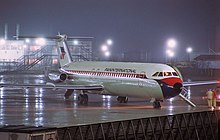Paninternational Flight 112
 D-ALAR, the BAC One-Eleven involved, seen nine months before the accident | |
| Accident | |
|---|---|
| Date | 6 September 1971 |
| Summary | Dual engine failure due to overheating after accidentally filling the water injection mechanism with jet fuel |
| Site | Bundesautobahn 7 53°42′10″N 09°56′33″E / 53.70278°N 9.94250°ECoordinates: 53°42′10″N 09°56′33″E / 53.70278°N 9.94250°E |
| Aircraft | |
| Aircraft type | BAC One-Eleven |
| Operator | Paninternational |
| Registration | D-ALAR |
| Flight origin | Hamburg Airport, Hamburg, Germany |
| Destination | Málaga Airport, Málaga, Spain |
| Occupants | 121 |
| Passengers | 115 |
| Crew | 6 |
| Fatalities | 22 |
| Injuries | 99 |
| Survivors | 99 |
Paninternational Flight 112 was a BAC One-Eleven operated by German airline Paninternational that crashed in Hamburg on 6 September 1971 while attempting to land on an autobahn following the failure of both engines. The accident killed 22 passengers and crew out of 121 on board.
Aircraft[]
The aircraft, registered as D-ALAR, had its first flight the year before the accident.[1]
Accident[]
Paninternational Flight 112 took off from Hamburg Airport in Hamburg, Germany, on a flight to Málaga Airport in Málaga, Spain, with 115 passengers and six crew on board.[1] After the take-off, both engines failed and the pilots decided to make an emergency landing on a highway – Bundesautobahn 7 (also part of European route E45)[2] – about 4.5 km (3 mi; 2 nmi) from Hamburg Airport.[1] During the landing the aircraft deflected to the left and collided with an overpass and multiple concrete pillars, causing the right wing, cockpit, and T-tail to shear off. The rest of the fuselage broke up and skidded to a halt; subsequently catching fire.[1] The accident killed twenty-one passengers and one crew member.[1]
Cause of the crash[]
Subsequent investigation showed that the tank for the water-injection engine thrust-augmentation system (used during take-off) had inadvertently been filled with jet fuel instead of water. Spraying this additional jet fuel into the engines during take-off significantly increased the engine rpm and quickly caused both engines to overheat and fail, resulting in the crash.[citation needed]
References[]
- ^ Jump up to: a b c d e Ranter, Harro. "ASN Aircraft accident BAC One-Eleven 515FB D-ALAR Hamburg-Fuhlsbüttel Airport (HAM)". aviation-safety.net. Aviation Safety Network.
- ^ "Autobahnatlas.de information for A7". www.autobahnatlas-online.de (in German). Retrieved 29 May 2010.
- Paninternational accidents and incidents
- Aviation accidents and incidents in 1971
- Aviation accidents and incidents in Germany
- Accidents and incidents involving the BAC One-Eleven
- Airliner accidents and incidents caused by engine failure
- September 1971 events in Europe
- Autobahns in Germany
